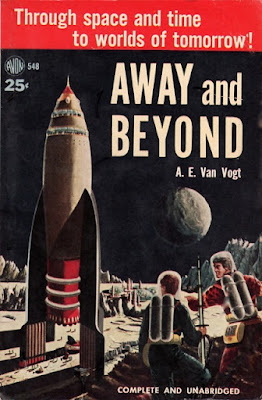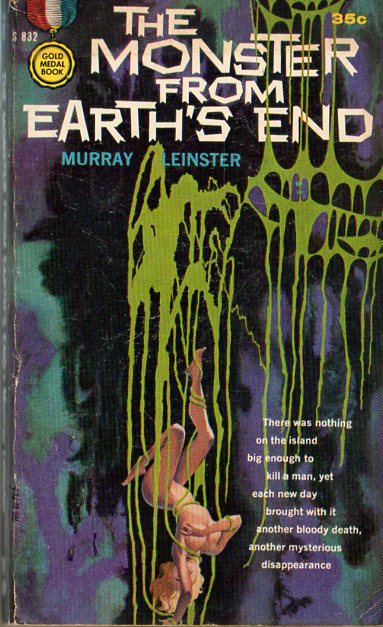"Away and Beyond" by A.E. Van Vogt
This collection of nine short stories, novelettes and novellas amply demonstrate(s) the
assured touch that van Vogt was apparently more than capable of bringing to the shorter form.
"The Great Engine," from the July '43 "ASF." In this one, a meteor damages a ship in outer space--a ship that the reader assumes to be of alien origin--and its torn-out propulsive mechanism crashes to Earth and half buries itself in a hillside in small-town America. It is discovered by former Air Force flyer Jim Pendrake, who is now living the life of a hermit, estranged from his wife, and embittered after losing his right arm in WW2 combat. Pendrake experiments with the mysterious engine, learns something of its peculiar features, and even inserts it into a Puma fighter to test its capabilities...only to have the device stolen from him at gunpoint by some very dangerous men. What follows, as Pendrake digs deeper into the machine's origin, is a tale of increasing paranoia and eventual cosmic wonder. Curiously, though apparently set shortly after the war's close, this story features any number of decidedly futuristic touches, such as an "electron image camera," a sleep drug called Denilin, "trilights" in living quarters, a habitable Venus, and the fact that Pendrake's wife seems to be a "sensitive" (i.e., telepathic). And yet, our protagonist here, embittered and one-armed as he is, most forcibly brings to mind the character that Harold Russell would play in "The Best Years of Our Lives" three years later. In all, a likeable story, although the function of that titular engine might have been a bit more lucently defined.
"The Great Judge," a short story from the July 48 issue of "Fantasy Book" magazine (a short-lived publication that only came out with eight issues from 1947 - '51), introduces us to one Douglas Aird, an inventor in the year 2460 who has just been sentenced to death for making disparaging comments about the absolute dictator of the story's title. With nothing left to lose, Aird uses his newest creation, which had successfully transferred the nervous impulses of a chicken into a dog, to effect a most ideal solution, both as regards his own dilemma and the despotic government in power. Ultimately, a wild, three-way mind-body transfer is demonstrated in this clever and snappy little tale.
Up next is the novella "Secret Unattainable," from the July '42 "ASF." I suppose one might call this an epistolary story, except what we are given here are not quite letters. Rather, the story takes the form of memos, precis, interview transcriptions, and telegrams between the Gestapo, the Reich's Bureau of Physics, and Heinrich Himmler and Adolf Hitler themselves, regarding an incredible new invention that was in the process of development by the disgruntled German scientist Johann Kenrube. Kenrube, it would seem, had recently discovered a method of traveling through hyperspace, and of tapping the mineral resources of far-distant planets...obviously a device of great desirability for the Nazi regime of 1937! This is a fairly brilliant and utterly convincing tale, its attention to historical detail quite remarkable. As we now know, the Nazis never did get to utilize this awesome device to capture the world, and this tale's many documents go far in explaining why not. Some slight points off for another device that is insufficiently explained by the author, but nevertheless, some very impressive work here; one of the finest pieces in this collection.
The following story, "The Harmonizer" (Nov. '44 "ASF"), largely transpires in the Cretaceous period, when dinosaurs were in their saurian prime, and concludes at the tail end of WW3. In this brief and slightly confusing story, an alien ship crash-lands on Earth 80 million years ago. Its occupants are all killed in the disaster, but 83 so-called "ibis plants" manage to survive, and are soon seen thriving in the swamplike terrain. These plants, thousands of years later, manage to effect a change in the dinosaurs around the world, in a manner that I probably should not reveal. Ultimately, this turns out to be a sweet little story, but, as I inferred, with one suggestion as to mankind's evolution that I just could not understand.
The collection's next offering, the novelette entitled "The Second Solution" (Oct. '42 "ASF"), seems to hark back a bit to van Vogt's very first story, "Black Destroyer"; the story that jump-started sci-fi's Golden Age in the legendary July '39 issue of "ASF." But instead of that earlier story's killer alien called the "coeurl," here, we are given the "ezwals." Thus, a mother ezwal and her baby are captured and brought back to Earth by a team of scientists. The ship catastrophically crashes in the wilds of northern Canada (a LOT of shipwrecks in this collection, as you can see!) but not before the order is given to kill both of the highly dangerous alien beasts. The mother is summarily executed, but the baby--a dark-blue, highly intelligent, square-headed, razor-clawed, six-legged, telepathic killer about the size of an adult lion--manages to survive both the slaying and the crack-up. It escapes into the forest, and begins to systematically kill its Earth enemies, both canine and human. This is a hugely entertaining and exciting tale, and is just one of the six stories that van Vogt would later cobble together, with the addition of some new connecting chapters, to create his 1959 "fix-up" novel "The War Against the Rull" (which I really do want to read now!). And BTW, it was van Vogt himself who came up with the expression "fix-up novel" back in the 1950s.
In "Film Library" (a novelette from the July '46 "ASF"), Mr. Lester Arlay is seen getting numerous complaints from his customers. Arlay, it seems, owns a business that sends various educational films to schools and corporations. But lately, these films have been displayed only to show scenes of the apparent future; documentaries dealing with stoves that prepare meals themselves, the repair of a spaceship's drive, Venusian squids, the recharging of an atomic gun, and many others! Arlay manages to trace the problem back to one of his best customers, a science teacher at Tichenor Collegiate, but I must admit that once again, the answer to this story's central conundrum is one that I could not even begin to explain to you. Sorry, but the author's explanatory mumbo jumbo to the effect that "Time is where you are. It is never the same elsewhere..." just did not work for this reader. A most unsatisfying story, thus; for this reader, anyway.
But the collection rebounds in a very big way with its final offering, "Asylum," a novella from the May '42 "ASF." Here, Jeel and Merla, a bickering husband-and-wife (?) team of a race called the Dreegh, arrive on Earth, famished unto death. They thus begin to do what they do best: suck the blood out of humans and, by kissing them on the mouth, drain all the electrical energy out of their bodies. These homicides, the first on Earth in 27 years (!), capture the attention of newspaper reporter Bill Leigh, who eventually becomes a pawn not just of the Dreegh invaders, but also of the Dreegh's enemy, the so-called Galactic observer who secretly resides on our fair planet. The story culminates in the depths of space, on a meteor base near the Jovian moon Europa, where Jeel and Merla are endeavoring to kill the Earth scientist Prof. Ungarn, while someTHING has taken over Leigh's brain and influences his actions from within. As you can see, this is a pretty far-out tale, a fast-moving and consistently mind-blowing one, with a great abundance of pleasing futuristic detail. Thus, we are given the wrist communicator that Leigh uses, Dick Tracy style; a mechanical psychologist that functions as a more advanced polygraph; a device to alter the credibility of one's memories; and a sort of space-age printer. This story keeps the reader guessing all the way to its final paragraphs, and really is a bravura piece of work from Mr. van Vogt, as well as a perfect closer for this generally pleasing collection.
So there you have it...seven stories, of varying lengths and of varying subject matter, most of them highly satisfying, a few not so much; all of them, however, beautifully written, in van Vogt's finest pulp style. How nice for me to discover that my old high school fave had such a winning way with the shorter form! "Away and Beyond" might entail a few minutes of Interwebs searching today, but trust me, it will reward your efforts. (Sandy, GoodReads)



Comments
Post a Comment